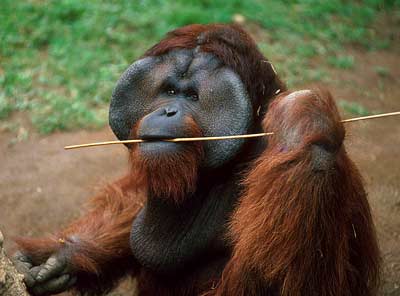 From LiveScience
From LiveScience
by Jennifer AbbasiFor many people, bestiality is a bad joke, but for some it could be a matter of life or death, according to a new study finding that men who had sex with animals in their lifetimes were twice as likely to develop cancer of the penis as others.
The study of 492 men from rural Brazil found that 35 percent of study participants, who ranged from 18 to 80 years old and included both penile cancer patients and healthy men, reported having sex with animals (SWA) in their lifetimes. A team of urologists from centers around Brazil co-authored the paper, which looked at risk factors for penile cancer in men who had visited 16 urology and oncology centers in 12 Brazilian cities. In addition to SWA, three other risk factors for penile cancer were found: smoking, the presence of premalignant lesions on the penis and phimosis, a condition where the foreskin cannot be retracted over the penis.
Men who had sex with animals also reported a higher incidence of sexually transmitted diseases.
Of the 118 penile cancer patients, 45 percent reported having sex with animals, compared with 32 percent of healthy men, who visited the medical centers for benign conditions, check-ups or cancer prevention. Fifty-nine percent of men who had sex with animals did so for one to five years, while 21 percent continued the behavior, also known as zoophilia, for more than five years. The subjects reported a variety of frequencies for their sex acts, ranging from monthly to daily. [
The researchers found no association between penile cancer and the number of animals the men used over time, the species (which included mares, cows, pigs and chickens, among other animals) or the number of other men who also participated. However, the higher rate of reported sexually transmitted diseases in men who had sex with animals could be a result of group sex, said lead author Stênio de Cássio Zequi, a urologist inSão Paulo. More than 30 percent of subjects practiced SWA in groups.
Thirty U.S. states, under their animal cruelty legislation, have enacted laws that prohibit sexual contact between humans and animals, according to Michigan State University College of Law.
Theorizing a causal roleSex with animals could be as ancient as sex itself. "Since time immemorial, this habit has been described in folk music, theater, jokes and oral traditions," Zequi told LiveScience. "In some antique civilizations there were temples or rituals designated for SWA practices." Yet SWA is underrepresented in scientific literature, and the new study is the first to link the practice to male genital cancers. Penile cancer accounts for up to 10 percent of cancers in men in Asia, Africa and South America, although it is rare in the U.S.
Micro-injuries to the penis are a well-recognized risk factor for the development of penile cancer. Such physical trauma could explain how sex with animals causes the cancer.
"We think that the intense and long-term SWA practice could produce micro-traumas in the human penile tissue," Zequi said. "The genital mucus membranes of animals could have different characteristics from human genitalia, and the animals' secretions are probably different from human fluids. Perhaps animal tissues are less soft than ours, and non-human secretions would be toxic for us," he explained.
Zequi theorizes that micro-lesions caused by this toxicity could facilitate the action of some yet unrecognized microorganism during contact between different mammalian species.
Tobias Köhler, a urologist at Southern Illinois University School of Medicine who was not involved in the research, said the study was rigorous. "It adds to our knowledge of cancer prevention and gives us epidemiological data we never really had before on sex with animals.”
Köhler, who specializes in sexual medicine, speculates that the friction during SWA causes micro-lesions. "The vagina in humans has moisturizing properties, which prevent penile injury. With animals, you're at higher risk for micro-trauma, like cuts and scratches. And then whatever pathogens are there, like bacteria and viruses, are more likely to cause a problem."
Köhler said it's "absolutely plausible" that microorganisms present during sex with animals could cause penile cancer, citing the fact that human papilloma virus (HPV) causes cervical and penile cancer.
He postulated that the lifestyle of men who have sex with animals could also be a factor. "The study reported that these men also have more sex with prostitutes," Köhler said. "Are they using condoms when they have sex with people? Are they engaging in higher infectious-risk anal intercourse with people?"
However, Zequi said that SWA remained as a significant risk factor for penile cancer in the analysis, independent of lifestyle choices.
Circumcision also seems to play an important role in the development of penile cancer in men who have sex with animals. In global populations where the foreskin is removed soon after birth, the rates of penile malignancies are near zero. Uncircumcised men may develop more micro-traumas during sex, according to one theory on why circumcision protects against cancer. Smegma, the white secretion that collects around the glans of the penis in uncircumcised men, is composed of fatty acids that have been shown to be highly carcinogenic, and could also help to explain the increased risk. [5 Myths About the Male Body]
"As the majority of subjects in our study were uncircumcised, or were circumcised later, this may have contributed to the incidence of penile cancer," Zequi said. "I have no doubt that when both the conditions are present in [the] same man, the risks are multiplied by each other, configuring the most unfavorable scenario andthe highest risk for this cancer," he said, referring to both an uncircumcised penis and incidence of sex with animals.
Not just a rural problemThe subjects recruited from the study all grew up in rural areas of Brazil. The researchers wrote that they chose this population to investigate because sex with animals is common in rural areas with high rates of penile cancer, and a connection seemed plausible. In fact, Zequi said he was not surprised that 35 percent of participants had had sex with animals.
"We know that in rural zones of our country, and probably worldwide, young men have sexual experiences with domestic animals," he said. Most of the subjects reported that they stopped having sex with animals when they began having sex with people.
Men who have sex with animals in developing countries are usually poor and illiterate, with little or no access to hygiene, health care or the Internet, Zequi said. The opposite is true in developed countries such as the U.S., where SWA seems to occur in the educated population.
A study published in in the Archives of Sexual behavior in 2003 examined the demographics of 114 self-defined zoophiles in the U.S., Australia, New Zealand and Europe. An online survey revealed that 36 percent lived in large cities and 83 percent were either college graduates or had completed some college. Forty-five percent of the respondents worked in informatics or technology, and some of them earned high incomes.
"SWA is not a sexual behavior limited only for poor rural populations," Zequi said. "It is actually a growing health concern today. Just give a few clicks on the search sites on the Internet and you'll come across numerous 'zoo' sites or virtual communities focused on bestiality, many of which are pornographic and sometimes with degrading images." Zequi wants men (and women) who have sex with animals to know that the practice could be hazardous to their health, and he wants clinicians to spread the word to at-risk populations.
Köhler agreed, saying, "From a penile cancer prevention point of view, SWA should be discouraged based on the results of this study." He recommended standard safety precautions with any type of high-risk sexual intercourse: Wear a condom.
The new study was published online Oct. 24 in the Journal of Sexual Medicine.--
REFERENCEZequi SC, Guimarães GC, da Fonseca FP, Ferreira U, de Matheus WE, Reis LO, Aita GA, Glina S, Fanni VSS, Perez MDC, Guidoni LRM, Ortiz V, Nogueira L, Rocha LCA, Cuck G, da Costa WH, Moniz RR, Dantas Jr. JH, Soares FA, and Lopes A. Sex with animals (SWA): Behavioral characteristics and possible association with penile cancer. A multicenter study. The Journal of Sexual Medicine DOI: 10.1111/j.1743-6109.2011.02512.xABSTRACTIntroduction. Zoophilia has been known for a long time but, underreported in the medical literature, is likely a risk factor for human urological diseases.
Aim. To investigate the behavioral characteristics of sex with animals (SWA) and its associations with penile cancer (PC) in a case-control study.
Methods. A questionnaire about personal and sexual habits was completed in interviews of 118 PC patients and 374 controls (healthy men) recruited between 2009 and 2010 from 16 urology and oncology centers.
Main Outcome Measures. SWA rates, geographic distribution, duration, frequency, animals involved, and behavioral habits were investigated and used to estimate the odds of SWA as a PC risk factor.
Results. SWA was reported by 171 (34.8%) subjects, 44.9% of PC patients and 31.6% of controls (P < 0.008). The mean ages at first and last SWA episode were 13.5 years (standard deviation [SD] 4.4 years) and 17.1 years (SD 5.3 years), respectively. Subjects who reported SWA also reported more venereal diseases (P < 0.001) and sex with prostitutes (P < 0.001), and were more likely to have had more than 10 lifetime sexual partners (P < 0.001) than those who did not report SWA. SWA with a group of men was reported by 29.8% of subjects and SWA alone was reported by 70.2%. Several animals were used by 62% of subjects, and 38% always used the same animal. The frequency of SWA included single (14%), weekly or more (39.5%), and monthly episodes (15%). Univariate analysis identified phimosis, penile premalignancies, smoking, nonwhite race, sex with prostitutes, and SWA as PC risk factors. Phimosis, premalignant lesions, smoking, and SWA remained as risk factors in multivariate analysis. However, SWA did not impact the clinicopathological outcomes of PC.
Conclusion. SWA is a risk factor for PC and may be associated with venereal diseases. New studies are required in other populations to test other possible nosological links with SWA.































